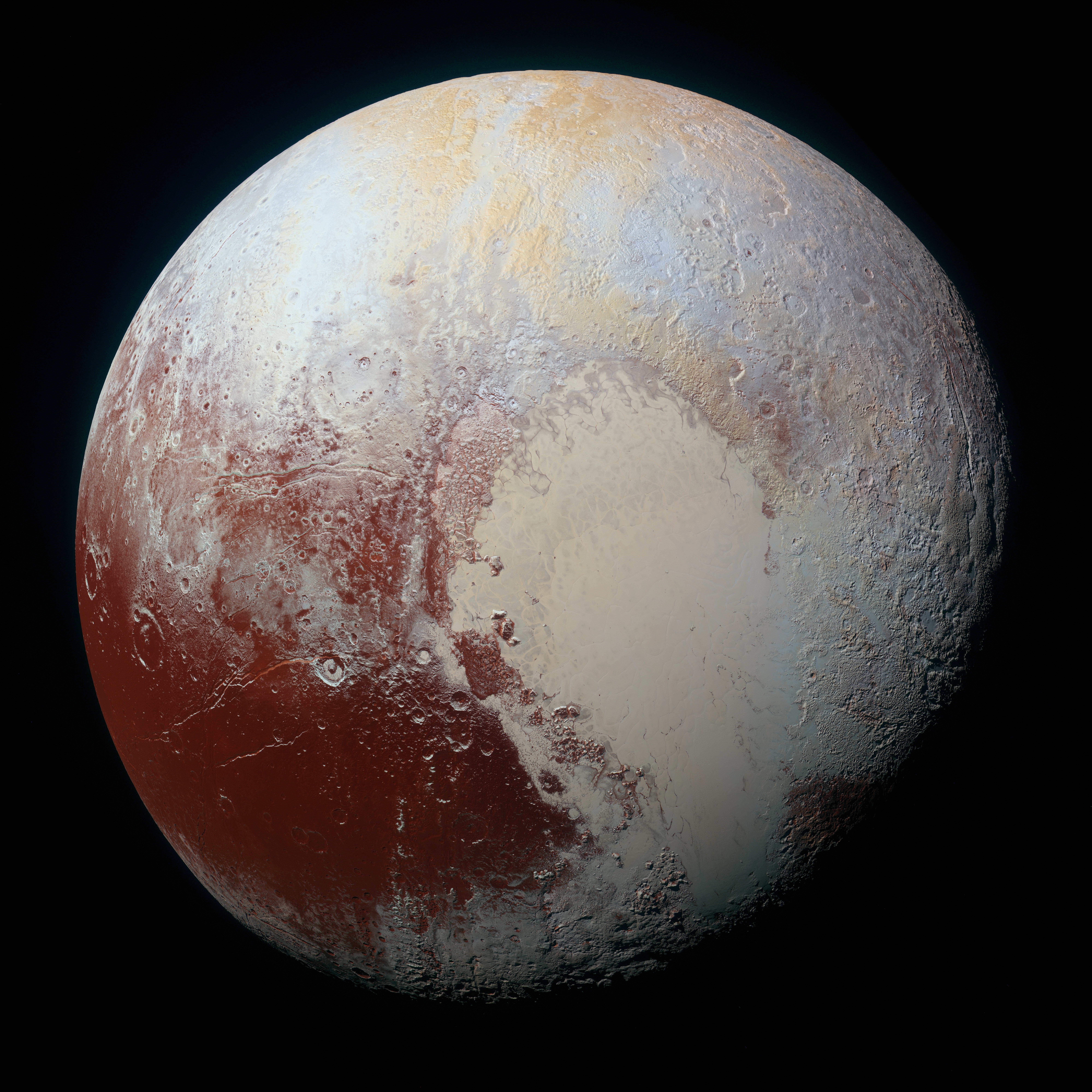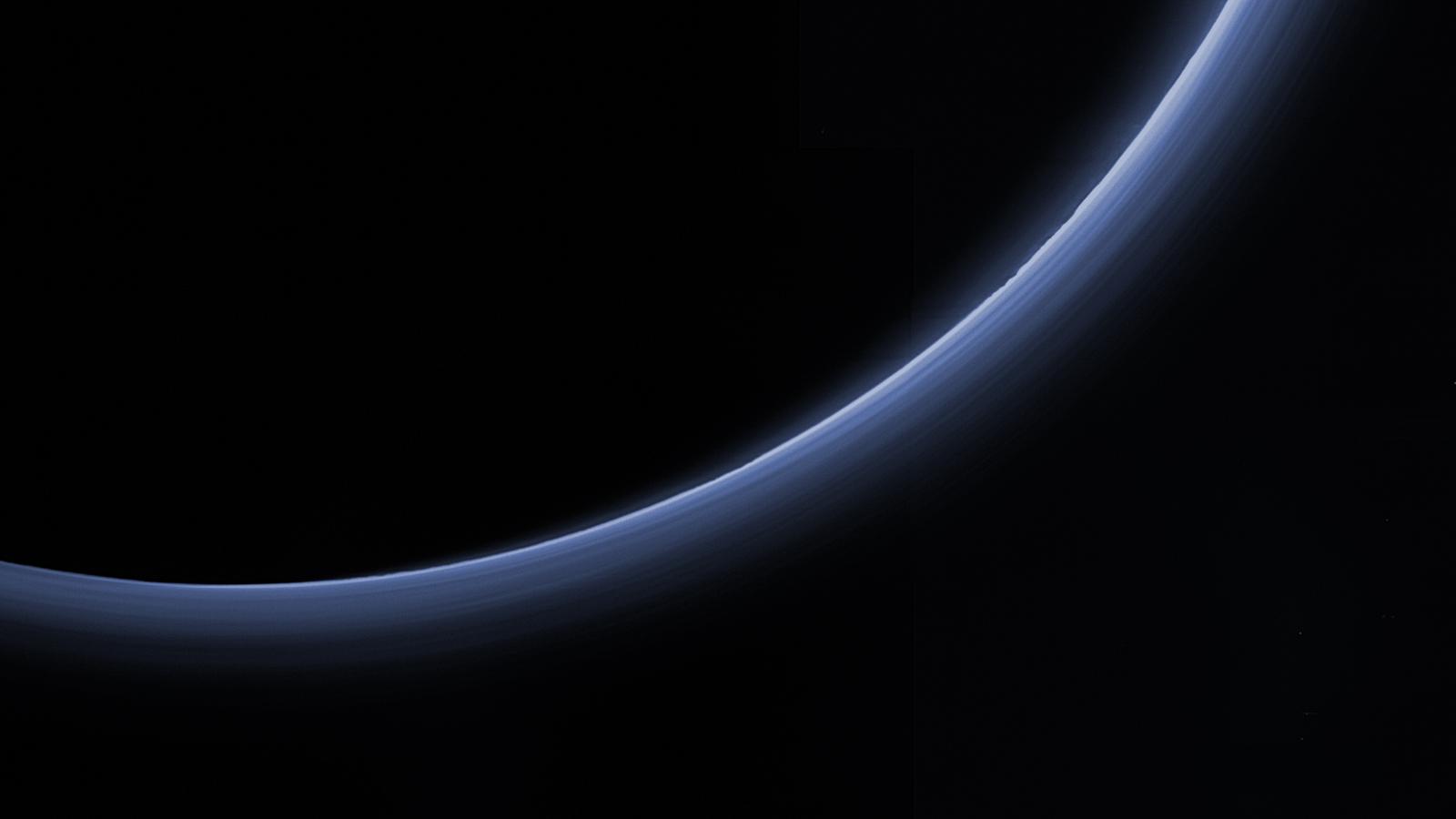|
Geology Of Pluto
The geology of Pluto consists of the characteristics of the surface, crust, and interior of Pluto. Because of Pluto's distance from Earth, in-depth study from Earth is difficult. Many details about Pluto remained unknown until 14 July 2015, when ''New Horizons'' flew through the Pluto system and began transmitting data back to Earth. When it did, Pluto was found to have remarkable geologic diversity, with ''New Horizons'' team member Jeff Moore saying that it "is every bit as complex as that of Mars". The final ''New Horizons'' Pluto data transmission was received on 25 October 2016. In June 2020, astronomers reported evidence that Pluto may have had a subsurface ocean, and consequently may have been habitable, when it was first formed. Surface More than 98 percent of Pluto's surface consists of solid nitrogen, with traces of methane and carbon monoxide. The face of Pluto oriented toward Charon contains more solid methane, whereas the opposite face contains more nitrogen a ... [...More Info...] [...Related Items...] OR: [Wikipedia] [Google] [Baidu] |
Atmosphere Of Pluto
The atmosphere of Pluto is the layer of gasses that surround the dwarf planet Pluto. It consists mainly of nitrogen (N2), with minor amounts of methane (CH4) and carbon monoxide (CO), all of which are vaporized from surface ices on Pluto's surface. It contains layered haze, probably consisting of heavier compounds which form from these gases due to high-energy radiation. The atmosphere of Pluto is notable for its strong and not completely understood seasonal changes caused by peculiarities of the orbital and axial rotation of Pluto. The surface pressure of the atmosphere of Pluto, measured by ''New Horizons'' in 2015, is about (), roughly 1/100,000 of Earth's atmospheric pressure. The temperature on the surface is , but it quickly rises with altitude due to a methane-generated greenhouse effect. Near the altitude of it reaches , where it then slowly decreases afterwards with height. Pluto is the only trans-Neptunian object with a known atmosphere. Its closest analog is the atm ... [...More Info...] [...Related Items...] OR: [Wikipedia] [Google] [Baidu] |
Tombaugh Regio
Tombaugh Regio (), sometimes nicknamed "Pluto's heart" after its shape, is the largest bright surface feature of the dwarf planet Pluto. It lies just north of Pluto's equator, to the northeast of Belton Regio and to the northwest of Safronov Regio, which are both dark features. Its western lobe, a -wide plain of nitrogen and other ices lying within a basin, is named Sputnik Planitia. The eastern lobe consists of high-albedo uplands thought to be coated by nitrogen transported through the atmosphere from Sputnik Planitia, and then deposited as ice. Some of this nitrogen ice then returns to Sputnik Planitia via glacial flow. The region is named after Clyde Tombaugh, the discoverer of Pluto. Description Tombaugh Regio is a large, light-colored region about across. The two lobes of the feature are geologically distinct. The western lobe, Sputnik Planitia, is smoother than the eastern, and they are of slightly different colors. Early speculation was that the western lobe may be a ... [...More Info...] [...Related Items...] OR: [Wikipedia] [Google] [Baidu] |
Viscosity
Viscosity is a measure of a fluid's rate-dependent drag (physics), resistance to a change in shape or to movement of its neighboring portions relative to one another. For liquids, it corresponds to the informal concept of ''thickness''; for example, syrup has a higher viscosity than water. Viscosity is defined scientifically as a force multiplied by a time divided by an area. Thus its SI units are newton-seconds per metre squared, or pascal-seconds. Viscosity quantifies the internal friction, frictional force between adjacent layers of fluid that are in relative motion. For instance, when a viscous fluid is forced through a tube, it flows more quickly near the tube's center line than near its walls. Experiments show that some stress (physics), stress (such as a pressure difference between the two ends of the tube) is needed to sustain the flow. This is because a force is required to overcome the friction between the layers of the fluid which are in relative motion. For a tube ... [...More Info...] [...Related Items...] OR: [Wikipedia] [Google] [Baidu] |
Volatile (astrogeology)
Volatiles are the group of chemical elements and chemical compounds that can be readily vaporized. In contrast with volatiles, elements and compounds that are not readily vaporized are known as refractory substances. On planet Earth, the term 'volatiles' often refers to the volatile components of magma. In astrogeology volatiles are investigated in the crust or atmosphere of a planet or moon. Volatiles include nitrogen, carbon dioxide, ammonia, hydrogen, methane, sulfur dioxide, water and others. Planetary science Planetary scientists often classify volatiles with exceptionally low melting points, such as hydrogen and helium, as gases, whereas those volatiles with melting points above about 100 K (–173 °C, –280 °F) are referred to as ices. The terms "gas" and "ice" in this context can apply to compounds that may be solids, liquids or gases. Thus, Jupiter and Saturn are gas giants, and Uranus and Neptune are ice giants, even though the vast majority of the "gas ... [...More Info...] [...Related Items...] OR: [Wikipedia] [Google] [Baidu] |
Cryovolcano
A cryovolcano (sometimes informally referred to as an ice volcano) is a type of volcano that erupts gases and volatile material such as liquid water, ammonia, and hydrocarbons. The erupted material is collectively referred to as ''cryolava''; it originates from a reservoir of subsurface ''cryomagma''. Cryovolcanic eruptions can take many forms, such as fissure and curtain eruptions, effusive cryolava flows, and large-scale resurfacing, and can vary greatly in output volumes. Immediately after an eruption, cryolava quickly freezes, constructing geological features and altering the surface. Although rare in the inner Solar System, past and recent cryovolcanism is common on planetary objects in the outer Solar System, especially on the icy moons of the giant planets and potentially amongst the dwarf planets as well. As such, cryovolcanism is important to the geological histories of these worlds, constructing landforms or even resurfacing entire regions. Despite this, only a fe ... [...More Info...] [...Related Items...] OR: [Wikipedia] [Google] [Baidu] |
Convection Cell
In fluid dynamics, a convection cell is the phenomenon that occurs when density differences exist within a body of liquid or gas. These density differences result in rising and/or falling convection currents, which are the key characteristics of a convection cell. When a volume of fluid is heated, it expands and becomes less dense and thus more buoyant than the surrounding fluid. The colder, denser part of the fluid descends to settle below the warmer, less-dense fluid, and this causes the warmer fluid to rise. Such movement is called convection, and the moving body of liquid is referred to as a ''convection cell''. This particular type of convection, where a horizontal layer of fluid is heated from below, is known as Rayleigh–Bénard convection. Convection usually requires a gravitational field, but in microgravity experiments, thermal convection has been observed without gravitational effects. Fluids are generalized as materials that exhibit the property of Fluid dynamics, f ... [...More Info...] [...Related Items...] OR: [Wikipedia] [Google] [Baidu] |
The Planetary Society
The Planetary Society is an American internationally-active non-governmental nonprofit organization. It is involved in research, public outreach, and political space advocacy for engineering projects related to astronomy, planetary science, and space exploration. It was founded in 1980 by Carl Sagan, Bruce Murray, and Louis Friedman, and has about 60,000 members from more than 100 countries around the world. The Society is dedicated to the exploration of the Solar System, the search for near-Earth objects, and the search for extraterrestrial life. The society's mission is stated as: "Empowering the world’s citizens to advance space science and exploration." The Planetary Society is a strong advocate for space funding and missions of exploration within NASA. They lobby Congress and engage their membership in the United States to write and call their representatives in support of NASA funding. In addition to public outreach, The Planetary Society has sponsored solar sai ... [...More Info...] [...Related Items...] OR: [Wikipedia] [Google] [Baidu] |
Sputnik Planitia
Sputnik Planitia (formerly Sputnik Planum) is a large, partially glaciated basin on Pluto. About in size, Sputnik Planitia is partially submerged in large, bright glaciers of solid nitrogen, nitrogen ice. Named after Earth's first artificial satellite, Sputnik 1, it constitutes the western lobe of the heart-shaped Tombaugh Regio. Sputnik Planitia lies mostly in the northern hemisphere, but extends across the equator. Much of it has a surface of irregular polygons separated by troughs, interpreted as convection cells in the relatively soft nitrogen ice. The polygons average about across. In some cases troughs are populated by blocky mountains or hills, or contain darker material. There appear to be windstreaks on the surface with evidence of sublimation (phase transition), sublimation. The dark streaks are a few kilometers long and all aligned in the same direction. The planitia also contains pits apparently formed by sublimation. No craters were detectable by ''New Horizons'', ... [...More Info...] [...Related Items...] OR: [Wikipedia] [Google] [Baidu] |







